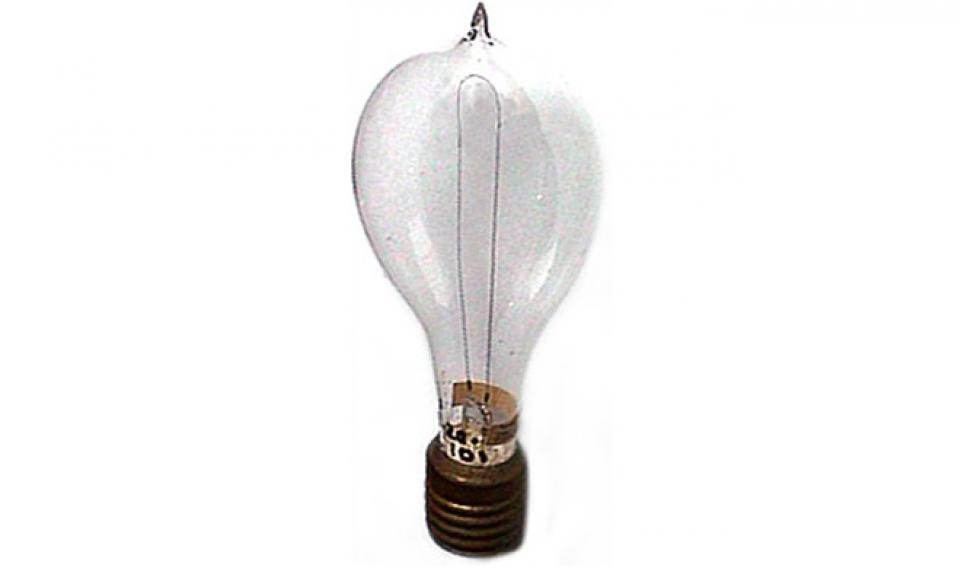Daily we turn them on and off. Edison and his assistants work nearly round the clock for months perfecting this, his best-known invention.
In the 1870's Thomas Edison, like many others, witnessed the brightness of the popular arc light of the time. The arc light was commonly used for street lamps and to light factories and shops. Edison had experimented with the idea of incandescent electric lights - a different method of lighting - though his efforts were focused on the phonograph. It was a challenge issued to Edison by Mr. G. P. Lowrey, an attorney with Western Union to, “...undertake an investigation of the electric light...” that pushed Edison to the development of the practical Incandescent light bulb.
Following a visit to the brass- manufacturing and arc light shops of William Wallace and Moses Farmer, Edison started his investigation. Farmer was the co-inventor of the first American electric dynamo. Edison commented on the arc light and its function saying, “I saw for the first time everything in practical operation. I saw the thing had not gone so far but that I had a chance.”
As Edison entered the fray to develop an incandescent light, he described to a New York newspaper reporter what his vision was. Edison predicted a central power station for electric lighting that he would create for all New York. >From the power station a network of electric wires would extend and deliver current for small household lights, unlike the blinding arc lights of the day.
Thomas Edison entered the arena of electric lights late. Several inventors were considerably ahead of him at this time. Edison's idea was to subdivide the intense light of one large light into many smaller, dimmer and less power consuming lights. His lights would be for domestic use and could be controlled individually.
Edison first researched the important issue of distribution. He focused his attention on the operations of the gaslight industry - an effective distribution industry that produced revenue of more than $150,000,000 annually at the time. Modeling his future system on this network was a wise, practical move.
Experiments with incandescent light already had a history that went back more than 50 years to the 1820's. Edison's initial experiments with the incandescent bulb proved to him that he was going to require more equipment, more staff, and much more money to carry out this job.
Investment money was acquired for the inventor and his Menlo Park laboratory through the work of Mr. G. P. Lowery. Lowery had excellent connections with the board members of Western Union and other New York notables. This investment brought about the creation of the Edison Electric Light Company.
Edison used the newspapers in New York City, the Sun, Herald and Tribune to boast about the arrival of the electric light. Edison later conceded that he needed several months or a year to, “get the bugs out.” Edison and his assistants faced their most difficult undertaking. They embarked on a work schedule that went on day and night.
The job at hand was so much more than finding the correct elements to construct a light bulb that would burn for a period of time. The job required building a complete lighting system, indeed, a new industry. First, a dynamo-engine combination that would consistently produce the proper voltage. Second, a network of wiring that could carry the voltage over a distance from the dynamos to light hundreds of small, individual lights. Edison was indeed creating, “...a whole new industry with all its ramifications.”
The light bulb garnered the immediate attention of the Edison team. Having experimented with several materials for the light bulb element (the element is the part that glows or incandesces when the electricity is passing through) ranging from various types of metals to beard hair. Carbonized thread proved to be initially successful. Not content with a light bulb that worked for 40 or more hours, Edison continued to experiment with other materials for the bulb element.
Edison and his assistants tested more than 6,000 plant materials as possible contenders for light bulb elements. Ultimately, carbonized bamboo (the bamboo was from Japan) proved the right choice because when cut to the proper dimensions and carbonized it incandesced for more than 1,200 hours when electrified. Bamboo also became a “convenient” choice at this particular point in the experimentation timeline. The use of bamboo helped Edison bypass some law suits involving other inventors who had developed the same procedure using carbonized thread.
So, a practical, commercial incandescent lamp was built and functioning. Now Edison had to complete the task with developing a “system” for the distribution of electric light in small units.
Following the development of the practical incandescent light bulb, Edison recounted the experience - “My laboratory was a scene of feverish activity, and we worked incessantly, regardless of day, night, Sunday, or holiday. I had quite a large force and they were a loyal lot of men as a whole, and worked with vim and enthusiasm. We accomplished a great deal in a short space of time, and before Christmas of 1879 I had already lighted up my laboratory and office, my house and several other houses about one-fifth of a mile from the dynamo plant, and some twenty street lights.”
At the time of Edison's death in October 1931, the electric and lighting industry was a five billion dollar a year industry in the United States.
Reference Material:
Edison A Biography , By Matthew Josephson, 1959, McGraw-Hill
The Beginning of the Incandescent Lamp and Light System , By Thomas Alva Edison (Autobiographical Account), 1976, The Edison Institute
